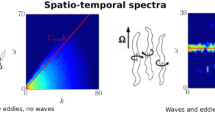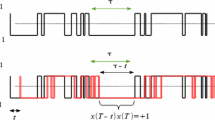Abstract
We consider the telegraph approximation (TA) of turbulent signals by ignoring their amplitude variability and retaining only their ‘zero’-crossing information. We establish a unique relationship between the spectral exponent of a signal and that of its TA, whenever the signal possesses a Gaussian PDF and a spectral shape in which the high-frequency cut-off is sufficiently sharp. The velocity signals in most turbulent flows away from the wall satisfy these conditions adequately, so that the Kolmogorov spectral exponent of −5/3 for the turbulent velocity spectrum corresponds to a −4/3 spectral exponent for its TA. By introducing a new scaling exponent to characterize the tendency of small-scale fluctuations to cluster, we show that the velocity and passive scalar signals display a finite tendency to cluster even in the limit of Re \(\rightarrow \infty\). We advance the notion, on the basis of the properties of the TA, that turbulent processes belong to one of two classes—either the ‘white noise’ type or the ‘Markov-Lorentzian’ type.
Similar content being viewed by others
References
G. I. Barenblatt and N. Goldenfeld, Phys. Fluids 7:3078 (1995).
J. T. Barnett and B. Kedem, IEEE Trans. Inform. Theory 37:1188 (1991).
A. Bershadskii, J. J. Niemela, A. Praskovsky and K. R. Sreenivasan, Phys. Rev. E 69:056314 (2004).
B. Castaing, Y. Gagne and E. J. Hopfinger, Physica D 46:177 (1990).
A. Deliu and B. Jawerth, Constr. Approx. 8:211 (1992).
G. Eyink, privite communication.
K. J. Falconer, The Geometry of Fractal Sets (Cambridge University Press, Cambridge, 1985).
G. Falkovich and K. R. Sreenivasan, Phys. Today xx:xxx (2006). A2
M. Hinich, Technometrics 9:391 (1967).
P. Kailasnath and K. R. Sreenivasan, Phys. Fluids 5:2879 (1993).
P. Kailasnath, K. R. Sreenivasan and J. R. Saylor, Phys. Fluids A 5:3207 (1993).
G. G. Katul, C. I. Hsieh and J. Sigmon, Boundary Layer Meteor. 82:49 (1997).
A. N. Kolmogorov, Dokl. Akad. Nauk. SSSR 30:9–13 (1941); reproduced in Proc. Roy. Soc. A 434:9–14 (1991).
M. R. Leadbetter and J. D. Gryer, Bull. Am. Math. Soc. 71:561 (1965).
V. S. L'vov and I. Procaccia, Phys. Rev. Lett. 74:2690 (1995).
G. Molchan, private communication.
A. S. Monin and A. M. Yaglom, Statistical Fluid Mechanics, Vol. 2 (MIT Press, Cambridge, 1975).
A. M. Obukhov, J. Fluid Mech. 13:77 (1962).
B. R. Pearson, P.-A. Krogstad and W. van de Water, Phys. Fluids 14:1288 (2002).
A. Praskovsky and S. Oncley, Fluid Dyn. Res. 21:331 (1997).
K. R. Sreenivasan, Phys. Fluids 27:1048 (1984).
K. R. Sreenivasan, R. A. Antonia and D. Britz, J. Fluid Mech. 94:745 (1979).
K. R. Sreenivasan and A. Bershadskii, J. Fluid Mech. (in print) 2005.
K. R. Sreenivasan and B. Dhruva, Prog. Theor. Phys. Suppl. 130:103 (1998).
K. R. Sreenivasan, A. Prabhu and R. Narasimha, J. Fluid. Mech. 137:251 (1983).
Author information
Authors and Affiliations
Additional information
PACS: 47.27.-i, 47.27.Gs, 47.27.Nz
Rights and permissions
About this article
Cite this article
Sreenivasan, K.R., Bershadskii, A. Clustering Properties in Turbulent Signals. J Stat Phys 125, 1141–1153 (2006). https://doi.org/10.1007/s10955-006-9112-0
Received:
Accepted:
Published:
Issue Date:
DOI: https://doi.org/10.1007/s10955-006-9112-0




